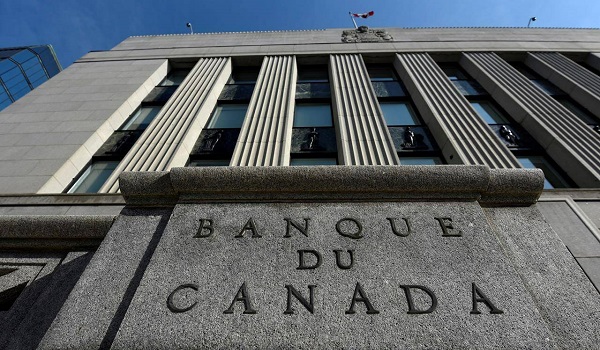Bank of Canada holds key rate steady at 5%, says discussions shifted away from raising more hikes
The Bank of Canada held its policy interest rate steady for the fourth consecutive time, and said that monetary policy discussions have shifted from whether to raise borrowing costs further to how long the bank should wait before lowering them as the Canadian economy has shifted into a state of “excess supply.”
The widely-anticipated decision keeps the bank’s policy rate at 5 per cent, a two-decade high reached last July.
While the bank remained on hold on Wednesday, there was a notable pivot in its language, which downplayed the odds of further rate hikes and opened the door to the possible rate cuts.
“With overall demand in the economy no longer running ahead of supply, Governing Council’s discussion of monetary policy is shifting from whether our policy rate is restrictive enough to restore price stability, to how long it needs to stay at the current level,” Bank of Canada governor Tiff Macklem said in a statement published alongside the rate announcement.
He did not rule out further rate hikes altogether, but suggested they were unlikely if inflation and economic activity develops in line with the bank’s projection.
With economic growth stalling and inflation hovering near the upper end of the bank’s 1 per cent to 3 per cent control range, analysts and traders expect the central bank to start cutting rates in the coming quarters. Most are betting the first rate cut will happen in April or June.
The bank gave no guidance about the timing of possible rate cuts.
Between the March, 2022 and last July, the bank raised interest rates 10 times to try to halt runaway inflation – one of the most aggressive monetary policy tightening campaigns on record. Higher interest rates make it more expensive for individuals and companies to borrow money and service debts, with the goal of cooling demand for goods and services and reducing upward pressure on prices.
Tight monetary policy is having its intended impact. Economic growth in Canada has stalled since the middle of 2023. Consumers have cut spending and businesses have pulled back on investment. Unemployment is rising as job creation has failed to keep pace with population growth, and job vacancies are back near pre-pandemic levels.
Taken together, the bank now thinks the Canadian economy is operating in a state of “excess supply.” That means there is less demand for goods and services than what the economy can produce, which should put downward pressure on inflation over time.
So far the economy has avoided an outright recession, which many economists were predicting this time last year. But the bank’s latest forecast, published Wednesday in its quarterly Monetary Policy Report (MPR), sees only 0.8 per cent GDP growth in 2024, although it expects economic activity to pick up around the middle of the year. It expects 2.4 per cent GDP growth in 2025.
The economic slowdown is feeding through to inflation, which has declined significantly from a peak of 8.1 per cent reached in mid-2022. Annual Consumer Price Index inflation hovered between 3 per cent and 4 per cent through the second half of last year, and came in at 3.4 per cent in December. The bank targets 2-per-cent inflation.
The new MPR forecast sees inflation remaining around 3 per cent for the first half of 2024, before falling to 2.5 per cent by the end of the year and back to the 2-per-cent target in 2025. This is largely in line with the previous projection from October, although marginally lower thanks to declines in oil prices.
Although Mr. Macklem highlighted the progress the bank has made fighting inflation, he said that he remains concerned about core inflation measures, which capture underlying price pressures, and warned that further declines in inflation “are likely to be gradual and uneven.” The bank’s two favourite core inflation measures have been stuck in the 3.5 per cent to 4 per cent range for the better part of a year.
Shelter inflation remains a particular concern. Mortgage interest costs have spiked – a product of the bank’s past interest rate hikes – while rents continue to rise quickly. House prices have also fallen less than the central bank expected, given the sharp jump in borrowing costs over the past two years.
“Persistent structural supply challenges and strong underlying demand from population growth will likely continue to put pressure on house and rental prices,” the bank said in its MPR. “While recent government actions should help moderate some of these constraints, the imbalances are expected to be resolved only gradually.”
The bank is also wary about the pace of wage growth. Despite a weakening labour market, average annual wage growth is running in the 4 per cent to 5 per cent range. The bank believes this is not compatible with 2 per cent inflation, unless there is a notable uptick in worker productivity.
“Governing Council wants to see further and sustained easing in core inflation and continues to focus on the balance between demand and supply in the economy, inflation expectations, wage growth, and corporate pricing behaviour,” the bank said in its rate announcement statement.
Mr. Macklem and senior deputy governor Carolyn Rogers will speak at a press conference at 10:30 a.m. ET.
This article was reported by The Globe and Mail














